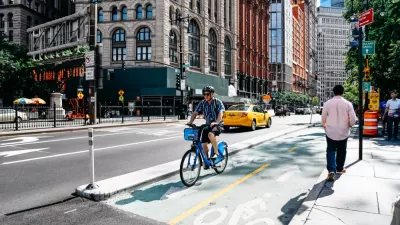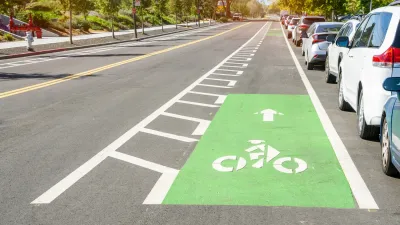The plan to reimagine Manhattan’s Third Avenue to make it safer for pedestrians and cyclists is being applauded by advocates, but some say the city should go further to provide more space for multimodal transportation.

A New York City street that some call “an inhospitable and dangerous traffic sewer” will soon be reimagined as a multimodal corridor, per a Streetsblog NYC article by Julianne Cuba.
After months of advocacy from local pols and activists — and a shiny spread in New York Magazine showcasing what a reimagined current seven-lane Third Avenue could be — the Department of Transportation on Wednesday night unveiled its plans to a Manhattan Community Board 8 panel to take away two lanes of moving traffic in order to make room for a protected bike lane and designated bus lane on the corridor between E. 59th and E. 96th streets.
According to Cuba, “The plan, which also includes taking away parking spaces near intersections to allow for pedestrian islands and shorter crossing times, will not only help cyclists, but also pedestrians and the more than 50,000 bus riders daily, who currently suffer from exhaustingly slow commutes on the more than 150 buses that traverse the thoroughfare.”
While approving of the new changes, some advocates want the city to install additional protective bike infrastructure and wider sidewalks, with the article indicating that “it’s well documented that the existing protected bike lanes on First and Second avenues are already overcrowded and in need of widening.”
Cuba notes that the project is expected to break ground next year, and plans for the rest of Third Avenue are yet to be finalized.
FULL STORY: Manhattan Panel Cheers City’s Third Ave. Redesign (Though Some Wish it Was Bolder)

Trump Administration Could Effectively End Housing Voucher Program
Federal officials are eyeing major cuts to the Section 8 program that helps millions of low-income households pay rent.

Planetizen Federal Action Tracker
A weekly monitor of how Trump’s orders and actions are impacting planners and planning in America.

Ken Jennings Launches Transit Web Series
The Jeopardy champ wants you to ride public transit.

Crime Continues to Drop on Philly, San Francisco Transit Systems
SEPTA and BART both saw significant declines in violent crime in the first quarter of 2025.

How South LA Green Spaces Power Community Health and Hope
Green spaces like South L.A. Wetlands Park are helping South Los Angeles residents promote healthy lifestyles, build community, and advocate for improvements that reflect local needs in historically underserved neighborhoods.

Sacramento Plans ‘Quick-Build’ Road Safety Projects
The city wants to accelerate small-scale safety improvements that use low-cost equipment to make an impact at dangerous intersections.
Urban Design for Planners 1: Software Tools
This six-course series explores essential urban design concepts using open source software and equips planners with the tools they need to participate fully in the urban design process.
Planning for Universal Design
Learn the tools for implementing Universal Design in planning regulations.
Heyer Gruel & Associates PA
Ada County Highway District
Institute for Housing and Urban Development Studies (IHS)
City of Grandview
Harvard GSD Executive Education
Toledo-Lucas County Plan Commissions
Salt Lake City
NYU Wagner Graduate School of Public Service





























